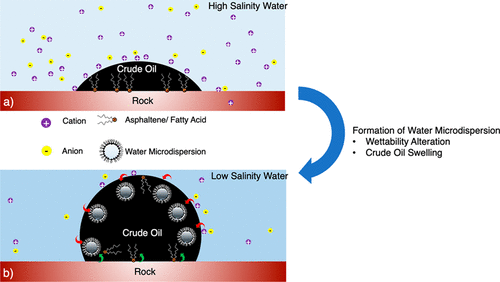当前位置:
X-MOL 学术
›
Energy Fuels
›
论文详情
Our official English website, www.x-mol.net, welcomes your
feedback! (Note: you will need to create a separate account there.)
Novel Insights into the Pore-Scale Mechanism of Low Salinity Water Injection and the Improvements on Oil Recovery
Energy & Fuels ( IF 5.2 ) Pub Date : 2020-09-14 , DOI: 10.1021/acs.energyfuels.0c01599 Mohammad Fattahi Mehraban 1 , Seyed Amir Farzaneh 1 , Mehran Sohrabi 1 , Adam Sisson 1
Energy & Fuels ( IF 5.2 ) Pub Date : 2020-09-14 , DOI: 10.1021/acs.energyfuels.0c01599 Mohammad Fattahi Mehraban 1 , Seyed Amir Farzaneh 1 , Mehran Sohrabi 1 , Adam Sisson 1
Affiliation

|
The long-held industry view that the Low Salinity Effect (LSE) depends mainly on rock–fluid interactions has led to failures and successes that can be explained by fluid–fluid interactions. Therefore, elevating our knowledge about the microscopic interactions occurring in the crude oil/brine/rock system appears to be of paramount importance. This paper chooses to outline various analytical tools in combination with a microfluidic instrument (Micromodel) to identify these interactions at simulated reservoir conditions for the first time (temperature and pressure of 50 °C and 2000 psi). In this study, six crude oil samples have undergone testing for microdispersion quantification and surface charge evaluation. Microdispersion is a term referring to the spontaneous formation of water clusters (in micrometer sizes) within the crude oil during low salinity water injection (LSWI), which will be elaborated in this study. Despite all samples showing the same trend regarding the negative surface charges, they showed an entirely different propensity toward formation of water microdispersion. The analysis of the oil/water interface by Fourier-transform infrared spectroscopy (FT-IR) led to the understanding that conjugated acidic compounds within the crude oil are the main compounds for the creation of water microdispersions. The Micromodel results revealed the predominant role of microdispersions in oil swelling and wettability alteration in a porous medium leading to an increase in the microscopic sweeping efficiency, thus leading to improved oil recovery. Also highlighted is the pivotal importance of water microdispersion as a screening method for oil reservoirs before waterflooding operation.
中文翻译:

低盐度注水孔隙机理的新见解与采收率的提高
长期以来,业界一直认为低盐度效应(LSE)主要取决于岩石与流体的相互作用,导致了失败和成功,这可以用流体与流体的相互作用来解释。因此,提高我们对在原油/盐水/岩石系统中发生的微观相互作用的认识似乎至关重要。本文选择与微流体仪器(Micromodel)结合概述各种分析工具,以首次识别模拟储层条件(温度和压力为50°C和2000 psi)下的这些相互作用。在这项研究中,对六个原油样品进行了微分散定量和表面电荷评估的测试。微分散是一个术语,是指在低盐度注水(LSWI)过程中原油中水团簇(以微米为单位)的自发形成,在本研究中将对此进行详细说明。尽管所有样品在负表面电荷方面都表现出相同的趋势,但它们对水微分散形成的倾向却完全不同。通过傅里叶变换红外光谱法(FT-IR)对油/水界面进行分析,从而使人们认识到,原油中的共轭酸性化合物是产生水微分散体的主要化合物。微观模型结果表明,微分散在多孔介质中油溶胀和润湿性变化中起主要作用,从而导致微观清扫效率提高,从而改善了采油率。
更新日期:2020-10-16
中文翻译:

低盐度注水孔隙机理的新见解与采收率的提高
长期以来,业界一直认为低盐度效应(LSE)主要取决于岩石与流体的相互作用,导致了失败和成功,这可以用流体与流体的相互作用来解释。因此,提高我们对在原油/盐水/岩石系统中发生的微观相互作用的认识似乎至关重要。本文选择与微流体仪器(Micromodel)结合概述各种分析工具,以首次识别模拟储层条件(温度和压力为50°C和2000 psi)下的这些相互作用。在这项研究中,对六个原油样品进行了微分散定量和表面电荷评估的测试。微分散是一个术语,是指在低盐度注水(LSWI)过程中原油中水团簇(以微米为单位)的自发形成,在本研究中将对此进行详细说明。尽管所有样品在负表面电荷方面都表现出相同的趋势,但它们对水微分散形成的倾向却完全不同。通过傅里叶变换红外光谱法(FT-IR)对油/水界面进行分析,从而使人们认识到,原油中的共轭酸性化合物是产生水微分散体的主要化合物。微观模型结果表明,微分散在多孔介质中油溶胀和润湿性变化中起主要作用,从而导致微观清扫效率提高,从而改善了采油率。











































 京公网安备 11010802027423号
京公网安备 11010802027423号